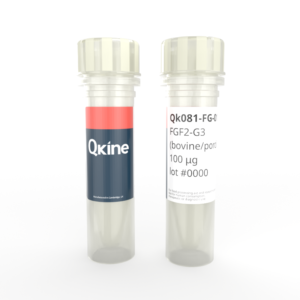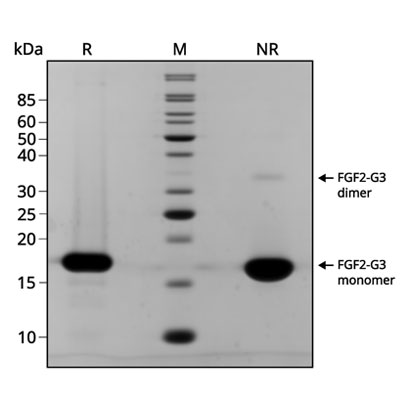 Recombinant bovine/porcine FGF2-G3 (154 aa) protein (Qk081-FG)
Recombinant bovine/porcine FGF2-G3 (154 aa) protein (Qk081-FG)Recombinant bovine/porcine FGF2-G3 (154 aa) protein (Qk081-FG)
£140.00 – £800.00

Recombinant bovine/porcine FGF2-G3 protein is a thermostable engineered form of FGF-2 (bFGF) with an increased functional half-life from <10 h (wild-type) to >7 days (FGF2-G3). Bovine FGF2-G3 is used for the development of optimized serum-free culture media for species-specific bovine (cow) and porcine (pork) cultivated meat and veterinary research applications, including the expansion of bovine and porcine smooth muscle cells, bovine and porcine induced pluripotent, embryonic and mesenchymal stem cells.
Recombinant FGF2-G3 is used in B8 media (Kuo et al. 2020) and Beefy-9 media (Stout et al. 2023) for weekend free, high homogeneity induced pluripotent stem cell culture. FGF2-G3 also has applications in chemically defined stem cell and organoid culture media.
Qkine high quality food grade bovine/porcine FGF2-G3 154 aa has a molecular weight of 17.1 kDa. This protein is animal origin-free, carrier-free and tag-free to ensure purity with exceptional lot-to-lot consistency.
In stock
Orders are typically shipped same or next day (except Friday).
Easy world-wide ordering, direct or through our distributors.
£140.00 – £800.00
1000µg will be despatched as 2 x 500µg
Fast and free shipping.
Buy online with secure credit card or purchase order. For any questions, please email orders@qkine.com
Summary:
- High purity thermostable bovine/porcine FGF2-G3
- 17.2 kDa (monomer)
High quality food grade recombinant protein
>98%, by SDS-PAGE quantitative densitometry
Animal origin-free (AOF) and carrier protein-free
Expressed in E. coli
Manufactured in the UK under a food manufacturing HACCP regime
Lyophilized from Tris, NaCl, CyS, mannitol
- Resuspend in sterile-filtered water at >50 µg/ml, add carrier protein if desired, prepare single use aliquots and store frozen at -20 °C (short-term) or -80 °C (long-term).
Featured applications:
Bovine and porcine stem cell expansion and maintenance
Cellular agriculture and cultivated meat cell culture media optimization

Recombinant bovine/porcine FGF2-G3 activity was determined using the Promega serum response element luciferase reporter assay in transfected HEK293T cells. EC50 = 415 pg/ml (24 pM). Cells were treated in triplicate with a serial dilution of FGF2-G3 for 3 hours. Firefly luciferase activity was measured and normalized to the control Renilla luciferase activity.
Recombinant bovine/porcine FGF2-G3 154aa migrates as a major band at approximately 17 kDa (monomer) in reduced (R) and non-reduced (NR) conditions. The dimeric form is also observed at approximately 34 kDa in the non-reduced condition. No contaminating protein bands are present. The purified recombinant protein (7 µg) was resolved using 15% w/v SDS-PAGE in reduced (+β-mercaptoethanol, R) and non-reduced (NR) conditions and stained with Coomassie Brilliant Blue R250.

Further quality assays
Mass spectrometry: single species with expected mass
Recovery from stock vial: >95%
Endotoxin: <0.005 EU/μg protein (below level of detection)
Full raw materials traceability, allergen analysis, CoO, CoA, beta-lactam-free and animal origin-free certification available
We are a company founded and run by scientists to provide a service and support innovation in stem cell biology and regenerative medicine. All our products are exceptionally high purity, with complete characterisation and bioactivity analysis on every lot.

WT FGF-2 (Qk056-FG) and FGF2-G3 (Qk081-FG) were diluted in conditioned media and incubated at 37 °C. Samples were taken at 0 and 2 days. FGF-2 activity was assayed in triplicate using the Promega serum response element luciferase reporter assay in transfected HEK293T cells. Results were then normalized to the maximum response for 0 hours. Comparison between Qk056-FG WT FGF-2 at 0 days (EC50 0.237 ng/ml) and 2 days (EC50 1.75 ng/ml. Comparison between Qk080 FGF2-G3 at 0 hours (EC50 0.464 ng/ml) and 2 days (EC50 0.606 ng/ml).
Protein background
FGF-2 (also known as basic FGF or bFGF) is an essential growth factor for maintaining embryonic stem cell (ESC) and induced pluripotency stem cell (iPSC) pluripotency in feeder-free and chemically defined stem cell media. It is a core component of widely adopted media including mTESR [1], StemPRO [2] and E8 [3]. However, FGF-2 is inherently unstable and prone to proteolytic degradation and aggregation. This fundamental biochemical instability, and therefore low half-life in culture media (<10 h), is an important contribution to the need for frequent media changes and challenges in improving homogeneity during stem cell proliferation and subsequent differentiation.
Bovine/porcine FGF2-G3 can be a core ingredient in Beefy-9 media, established by Stout et al. in 2023. The innovation of adding recombinant albumin to B8 media has yielded a ground breaking advancement in cell culture for the growth of bovine satellite cells, resulting in the development of Beefy-9 media. This novel medium is the first of its kind, meeting fundamental criteria to serve as a foundational medium for cultured meat production. One key feature includes the complete absence of animal-derived components, ensuring animal-component-free culture conditions. This departure from traditional serum-containing media, which often rely on animal-derived additives, distinguishes Beefy-9’s commitment to ethical and sustainable practices in cell culture [4-6].
Additional resources
FAQ
Fibroblast growth factor 2 (FGF-2), also known as basic fibroblast growth factor (bFGF) is a growth factor and signaling protein.
FGF-2 is expressed in a developmental and tissue specific manner. It’s expression is tightly controlled in normal tissues and it can be detected in all major tissues.
FGF-2 is essential for normal embryonic development. It has roles in cell survival and proliferation, angiogenesis, tumorigenesis, wound healing and tissue repair.
FGF-2 binds to and signals though all four of the FGF receptors FGFR1-4.
FGFRs phosphorylate specific tyrosine residues and activate the RAS-MAPK, PI3K-AKT, PLCγ, and STAT intracellular signaling pathways.
FGF-2 is used to maintain the pluripotency of stem cells in culture.
Our products are for research use only and not for diagnostic or therapeutic use. Products are not for resale.

Receive an Amazon gift voucher when you leave us a review.
£25, $30 or €30 for reviews with an image and £10, $15 or €15 for reviews without an image